Day Tour in the North of Mauritius

In the north-west of the island, the weather is over the year better than in the remaining part of the island; this is why there are numerous beautiful hotels and dream beaches in the north-west. We start from our holiday place Trou aux Biches our tour to the north of the island that nearly takes a whole day. During our tour we visit a lot of beaches, hotels and a few holiday regions. But we enjoy also two gorgeous temples, labouriously made ship models and a huge plant and palm paradise in the botanical garden of Pamplemousse.
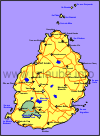
We drive on very well arranged roads so that we can drive fast. But we repeatedely stop in order to see the landscape; Also the drive through the huge sugar cane plantations is a new adventure to us. The adjacent map shows our route that starts in Trou aux Biches and ends in the neighboured place Triolet.
Trou aux Biches
The starting point from out north tour through Mauritius is the bathing resort Trou aux Biches; here, there is our hotel, from here we start in northern direction. But for those who do not live in Trou aux Biches, I recommend a side trip to this place. While the place itself is not really inviting, the long extended sand beach is the more attractive and invites to have a long extended walk. By the way, Trou aux Biches means in English doe-hole; Where this strange name comes from and/or how it is to understand is a thing I cannot say.
A big part of the beach belongs to the adjacent hotels, but the beach is public and this is specially noticeable in the week-ends, when numerous local people make an excusion to the sea. And in the beach of Trou aux Biches, after swimming barely 30 m into the sea, there are already some sightly corals in the sea ground and one sees many colourful fishes, thus a paradise for snorkeling beginners.
Grand Baie
From Trou aux Biches, we drive alongside the coastal road to Grand Baie, the big touristic centre of the island. Those who are looking for a bathing resort in Mauritius the way one also finds it in the Canarian Islands or the Balearic Islands, have to go to Grand Baie. In Grand Baie one soon forgets that one is actually not in the Mediterranean area but in the south Indian Ocean. Here, there is a 5 km long promenade, where the houses are strung together. As a pedestrian, one curls from one shop to the next one, banks, restaurants, t-shirt shops strung together as pearls. And of course, one also finds here all possibilities to do watersports: the providers are located right at the bay and talk to each of the passing tourists.
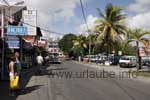
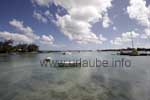
Apropos bay: Grand Baie is, as the name already says, a big bay, it is like a big sea swimming pool that is bordered by panhandles. Due to this, the beaches are naturally protected against high waves. But the bay also has the disadvantage that from some beaches, one cannot look to the "real" sea, thus there is no view to the open sea but only to the bay border; this is not everyone's cup of tea. In Grand Baie, there are numerous hotels, from simple accommodations to purely luxury temples with own beaches. But there are also some public beaches that partly are well equipped by a good infrastructure (toilets, kiosks etc.). But the beaches are not really beautiful if they are compared with the long beach of Trou aux Biches.
For visiting Grand Baie, one hour of time is enough. If one is so lucky to find a parking place in the centre of the place, one simply walks alongside the main road. If one does want to spend the holidays here or not is a matter of taste. For some, the business life on the streets and the nightlife is also a part of the holiday as the beach and the sea are; but others prefer to have some calmness in Mauritius. But we find again some calmness in the following places of our north tour.
Péreybère
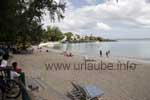
After we passed the long extended touristic place Grand Baie, we arrive as the next station to Péreybère. In this small place we experience the opposite of what we saw in Grand Baie. This place does not only belong the tourists but also the local population. Péreybère has a nice and small sand beach that invites to have a bath. Here, we barely find some tourists but nearly exclusively French speaking inhabitants of the island. While during the week it is not a problem to park right at the beach, the beach area bursts at the seams in the week-ends when numerous island inhabitants go to visit the nice beach.
What do we find in the beach of Péreybère? Actually everything what a tourist and/or the inhabitant needs: there is a nice restaurant where one can sit comfortably, in mobile sales booths ice-cream, drinks and small snacks are sold, there are toilets and also some benchs to sit down in the shadow upside the beach. In short words, it is a nice, small and cozy place with its centre in the beach where one can watch a lot of inhabitants.
Cap Malheureux
From Péreybère, there are only a few kilometres to the most northern point of the island, the Cap Malheureux. In English, Cap Malheureux means cape of misfortune. Where this name came from also the Mauritians are not agree upon, apparently there are several legends and interpretations. We do two stops at the Cap Malheureux, first at a small view point behind a bigger cementary. Still before we enjoy the view, we are impressed by the huge Banyan-trees that adorn the environment. These partly huge trees sometimes only consist on a single trunk of a thickness of several metres but sometimes also on several single trunks that are all communicated by the roots.
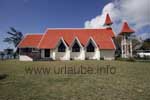
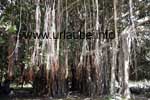
From the Cap Malheureux we enjoy a phantastic view to the islands that are located in front of Mauritius at the north, Coin de Mire, Ile Plat and Ilot Gabriel. All these islands are not inhabitated and are under natural protection. But with the boats, they are partly accessible and permit to have a pleasant stay on the beach or a nice snorkeling excursion.
From our view point at the Cap Malheureux, we continue driving for approximately one kilometer and get to a very nice small chapel right at the shallow seashore. It is a roman catholic chapel that is opened during the day. The interior is very simply arranged, it is nicely cool for relaxing a liitle from the heat. As this point is approached by each passing tourist, some mobile merchants settled here to provide the travellers some drinks, snacks and other stuff.
Goodlands
During our further drive anlongside the northern coast we arrive as the for the time being last place that is right at the sea to Le Grand Gaube. From a little parking place we get straight to the beaches with their small seawalk behind them. We soon notice that the place is mainly marked by some big hotels and we do not find anything interesting anymore and continue driving out tour into the heartland.
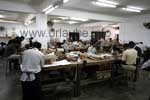
After a few kilometres driving we arrive at the place Goodlands. It is the biggest city in the north of Mauritius, the inhabitants are nearly purely Hindoos and this is the reason why there is a beautiful and small Hindoo-temple to visit; Not far from this temple we visit a factory for model ships. Those who already visited before other factories of model ships in the south of the island, will recognize soon that this is the most exclusive of all. Exclusive is not only the manufacturing, the tour and the exhibition room, specially exclusive are also the prices, not to say exorbitanty high. With prices of some hundred euros for the small models and some thousand euros for the bigger beauties, some of the souvenir collectors may get scarred.
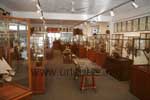
Even if I could not/ did not want to afford anny of these small ships, the visit to this model ship factory. First we had a short guidance through the factory itself; then we could look the workers over the shoulder. It was fascinating to see with which technical skill the tiny parts were assembled to a total object. If then one learned that to make the bigger ships a work of several months are needed, the prices suddenly seem to be really reasonable. After the visit of the workshop we could survey in a posh and big exhibition room numerous finished model ships. It was very interesting to have a well known ship that sunk long time ago right in front of one and palpable.
Poste de Flacq
From Goodlands we drive back to the coast and arrive as next place at Poudre d'Or, that is actually not a worth seeing place; the only reason to stop here was according to my opinion the possibility to be transferred by the fishermen to the islands at the front, Ile d' Ambre or Ilot Bernache, as with its gorgeos white beaches they invite to bath and relax unhurriedly. But we continue driving in southern direction to Poste de Flacq.
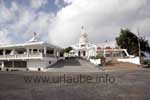
During our trip we already notice that in this area of the coast there is a stronger wind than the until then most known western coast. Here, while we pass by, we can watch some fast sail boarders and kite boarders. We finally land in a lonely place, in which a wonderful Hindoo temple is presented to us on a small peninsula that goes far into the sea. Of course, we are also enthusiastic about the numerous colourful temple figurines, but we also enjoy the calmness of this picturesque and lonely place on the small peninsula.
From Poste de Flacq we return to the west side of the island, but therefore we have to cross completely the island, a thing that takes some time, as there are no main roads in this direction and we are held up at several small places. On the half way we get to a colonial house named Château de Villebague. There is nothing to see, as the house is in private ownership. We can only guess what a gorgeous mansonries there must be hidden behind the high hedges and portals.
Botanical Garden in Pamplemousses
As the next bigger station of our north tour we visit the botanical garden of Pamplemousses; Even if until now, the tour was not really short, we have to experience this highlight and have therefore to calculate approximately 1,5 hours time, whereby I straight want to mention that the botanical garden of Pamplemousses is also a half day excursion or even a full day excursion worth. As we repetedely meet in the huge complex big groups of local school classes, we soon notice that this place is not only something for tourists but also a recreation area for the mauritian population. Specially in the week-ends many inhabitants of the island drive to the park for having a picknick.
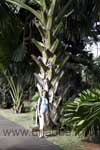
What is expecting the visitor in the botanical garden? In short words: there is nearly no exotic/southern palms and fruits, that one does not find in this botanical garden. Here, one finds all tropical kinds of palms and many trees/plants that we only know from their fruits, for example: cinnamon, nutmeg, papaya, cloves, lychees, ginger, ylang-ylang. It is fascinating to see in reality what one until then only knew form the can or from the veg stall. Of couse, the famous water lilies from the Amazon area with their bulged edges are specially fascinating, that are partly so stable that an infant could be sat in. And it is also fascinating to try the lotus effect by oneself with a big lotus petal leaf.
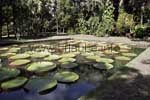
Those who do not have an expert guide can rent one at the entrance of the garden. This is also urgently recommended as without any guidance, one indeed gazes at the most different kinds of plants, trees and plams, but only a guide tells one the names that are hidden behind all this abundance of plants. In the centre of the garden one finds a big and gorgeous colonial house from the year 1777 and right beside it also some kinds of animals; I found the most interesting how the giant turtles of Seychelles unhurriedly munched some grass bunches.
There is still to mention that the botanical garden of Pamplemousses did not cost us any entrance fee, thus one could simply walk in. And there is another positive thing to mention that is that there are nukmerous public toilets in the park. Conclusion: the visit of this botanical garden is an absolute must in Mauritius; here, one will not only be impressed by the size and the variety of the plants, but one also learns a lot of the things one always wanted to know.
Triolet and the Shivalah-Temple
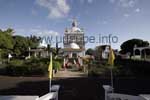
On our way back to Trou aux Biches we drive through the long extended place Triolet. With a length of more than 5 km, Triolet is the most long extended place of the island. We find one shop after the next on the long main road, numerous merchants simply sell their fruits right on the street. But we also find some banks and small supermarkets. Those who leave the main road and walk a few metres sideways will soon cpome out at nowhere. As it is the case in most of the small cities, in Triolet life take sonly place on one single road; sideways, neither the streets are well arranged nor there is anything to see.
At the city limit of Triolet we do a small sidetrip to a beautiful and colourful temple. It is the Hindoo Shivalah-temple. In Triolet, almost Hindoos do live, the temple is practically their religious centre. It was started to be built in the year 1891 and today, it is the biggest Hindoo temple in Mauritius. The temple complex consists on a big main building and several side buildings. All buildings are colourfully adorned and very colourful, either in the exterior as also in the interior. Some Beautiful green areas round in a wonderful way the harmonical picture of this religious place.

Back to the index Mauritius
Copyright: Patrick Wagner, www.tourist-guide.biz
|